|
- Catalog (in stock)
- Back-Catalog
- Mail Order
- Online Order
- Sounds
- Instruments
- Projects
- History Face
- ten years 87-97
- Review Face
- our friends
- Albis Face
- Albis - Photos
- Albis Work
- Links
- Home
- Contact
- Profil YouTube
- Overton Network
P & C December 1998
- Face Music / Albi
- last update 03-2016
|
1. Tungalag tamir, river tamir – long song (aizam urtiin duu) – 6:39
2. Um zandan shiree, the almond wood table – short song (bogino duu) – 1:45
3. Ulemjiin chanar, song of the poet Danzanravjaa – short song (bogino duu) – 9:04
4. Durtmal saikhan – long song (aizam urtiin duu) – 6:03
5. Shargal taliin tsetseg, yellow flower on the field – long song (besreg urtiin duu) – 2:59
6. Khuurkhun khaliun, yellow-brown horse – long song (besreg urtiin duu) – 2:45
7. Gariin arvan khuruu, ten fingers – short song (bogino duu) – 3:17
8. Khoyor setgel, two mind – short song (bogino duu) – 1:46
9. Nariin khukh mori, a blue horse – long song (besreg urtiin duu) – 3:37
10. Khar mori, black horse – short song (bogino duu) – 1:52
11. Jiijuu khot, name of a little town – short song (bogino duu) – 4:13
12. Arvaar avsan alag, ten coloured bought – short song (bogino duu) – 1:13
13. Khoyor bor mori, two brown horses – long song (suman urtiin duu) – 4:59
14. Naiman arslant, eight lions – magtaal (praising song) – 3:35
15. Shashnii duu – a Buddhist prayer – 5:09
16. Asar undur, song of the Bayanbarat – long song (aizam urtiin duu) – 5:31
The ensemble was founded in 1997. All its members have studied at the academy of music in Ulaanbaatar.
The Mongolians conferred the title Khan Bogd (Khan = King) to their highest-ranking ruler (tribal chief) of the tribes. In the Mongolian language this designation is also used for important or holy mountains or even whole mountain ranges.
There are performed short songs (bogino duu) and long songs (urtiin duu), with the female voice assuming an important role. The songs are about nature, man, animals (especially the horse) and the land of the Mongolian in general.
|
| Urtiin duu (long song) melismatic and richly ornamented, with a slow tempo, long melodic lines, wide intervals and no fixed rhythm. |
It is sung in verses, without a regular refrain and with a full voice in the highest register. The melody has a coat, which covers three octaves. This requires a strict observance of the breathing rules. The breathing is actually free, but the singer has to keep the strict rules of performance, making only the absolutely necessary breathing breaks without interrupting the melodic ornaments. The richer the voice is and the longer the singer can hold it, the more intensive is the attention paid by the audience and the more appreciated is this performance.
People usually practise these long songs while being alone in the open steppe and slowly riding along. The repertory is an expression of the liberty and the vastness of the Mongolian steppe and is used to accompany the rites of the seasonal cycles and the ceremonies of everyday life. Long songs are an integral part of the celebrations held in the round tents, and they must be sung following the strict rules of performance. |
|
|
Besreg duu - the shortened one have short verses, refrains, and melodic courses full of leaps and bounds. |
|
Bogino duu (short song) - strophic, syllabic, rhythmically tied, sung without ornaments. |
|
Short songs are never sung at celebrations, since they are spontaneously improvised and rather satirical. They are often sung in the form of a dialogue and speak of certain friends and incidents, or they are lyrical tales about love, about everyday life and about animals, especially horses. |
The Mongolian songs have a rich repertory. Music spread from ger to ger on the occasion of festivities and by way of teaching. The family or the clan meeting constituted a good opportunity to gather and sing together, the chance to learn from others, and to take home a new melody. In this way, the ancient patterns performed in various corners of Mongolia have been preserved by local masters for the whole nation.
The nomad shepherds in Mongolia, like other nomads from Central Asia, used to play string and wind instruments. The national music of Mongolia has had a rich background and a great tradition that goes back many centuries. Ensembles (orchesters) have performed at court or in the monasteries for lamaistic celebrations or in ritual ceremonies. Ensembles also play for daily rites in the ger (yurt – round tents). The morin khuur (horsehead violin or 'fiddle') (morin = horse; khuur = sound, rhyme, melody) is the most important traditional instrument for dance and to accompany songs. It is the national instrument.
Songs
|
1. Tungalag tamir, River Tamir – long song (aizam urtiin duu) |
|
Tamir, name of a river with clear water. |
|
- Nomin-Erdene Battulga: female voice, Togtokhjargal Buyankhishig: morin khuur |
|
In this song there are described the clear water and the beautiful river - its surroundings with the flowers and the green, strong grass, which flourishes due to the clear water and the pure air. It gives happiness and satisfaction to the people who live and work there. The rushing of the water is like music - it may be heard even far, far away. The water wells up from the mountain and finds its way through the valley, in this way forming landscapes of which people use to dream of - something we would not like to miss out on. |
|
If women sing this song several times a day, this is said to dissolve their sadness and sorrow. |
|
|
|
2. Um zandan shiree, the almond wood table – short song (bogino duu) |
|
- Nomin-Erdene Battulga: female voice, Togtokhjargal Buyankhishig: morin khuur, Uyanga Gankhuya: khuuchir, Solongo Gankhuyag: yatga |
|
A woman cleans this almond wood table and makes it really shine. Consequently, she puts milk and fruit on the table, prepared for her husband's guests. They sit together and enjoy the meeting and the wonderful time they spend at this splendid table.
|
|
- There is also a little story about this almond wood table:
|
|
A wise Mongol complains about the Manchurian ruler. (The Manchus were very strict rulers, and the Mongolian population had to suffer a lot). The prince learns about the complaints. For this reason, he wants to sentence the Mongol to death. The prince then, however, shows some lenience and offers him the opportunity to annul the sentence, and he says, "If you praise and sing for this almond wood table in my presence, I will show mercy."
The condemned man hence starts to improvize a praisal song about this beautiful hand-carved table made from almond wood. He praises the fineness and smoothness of its wood and the beautiful shine and brilliance of the coulours, and he emphasizes its good smell. |
|
|
|
3. Ulemjiin chanar – short song (bogino duu) |
|
A song of a dance performance of the poet Danzanravjaa, who lived in the southeast area of the Gobi and founded his own theatre. He wrote many poems, songs and also mask plays. (Dogshin khutagt Noyon Danzanravjaa) |
|
- Nomin-Erdene Battulga: female voice, Togtokhjargal Buyankhishig: morin khuur, Uyanga Gankhuya: khuuchir, Solongo Gankhuyag: yatga |
|
He once loved a woman like the Green Tara, with a soft heart and a good soul, a highmindedness. Many people were really happy when they could watch her perform dancing and also singing.
|
|
The song tells of such women who talk in a flowery way, who have a soft heart and would respect nature with a good soul, like the Green Tara. If you have the chance to meet such women, everything will turn out all right, you will find satisfaction and happiness and may enjoy your life with the sure prospect of a good future. |
|
The Mongolian people believe that, if they sing this song, the Green Tara will make this come true a thousand times, that they will find peace and happiness, and also the power to solve their problems. |
|
|
|
4. Durtmal saikhan – long song (aizam urtiin duu) |
|
- Nomin-Erdene Battulga: female voice, Togtokhjargal Buyankhishig: morin khuur |
|
Men and horses in Mongolia have the same character. In this song, such good men and horses are praised. The song further describes the life of the nomads. |
|
|
|
5. Shargal taliin tsetseg, yellow flower on the field – long song (besreg urtiin duu) |
|
Traditional song from the Bayankhongor aimag in Southwestern Mongolia. |
|
- Nomin-Erdene Battulga: female voice, Togtokhjargal Buyankhishig: morin khuur |
|
This song describes autumn in Mongolia, when the meadows and the landscape turn yellow. The wind starts to blow stronger and stronger, and the nomads set off for their winter pastures. |
|
|
|
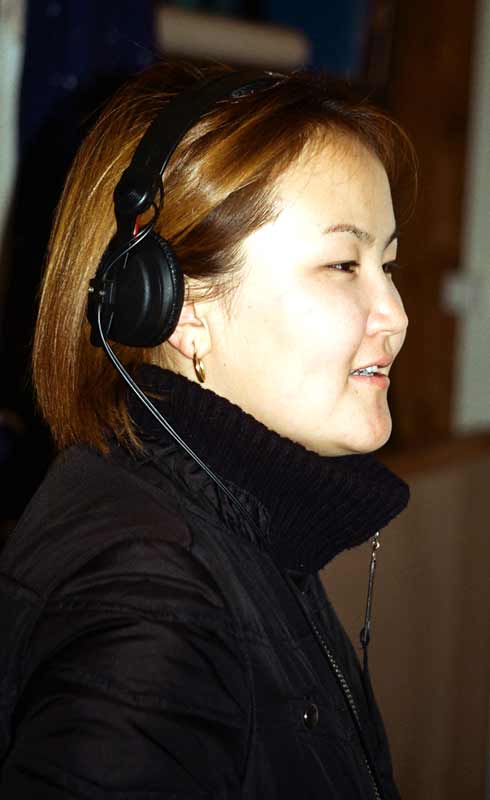 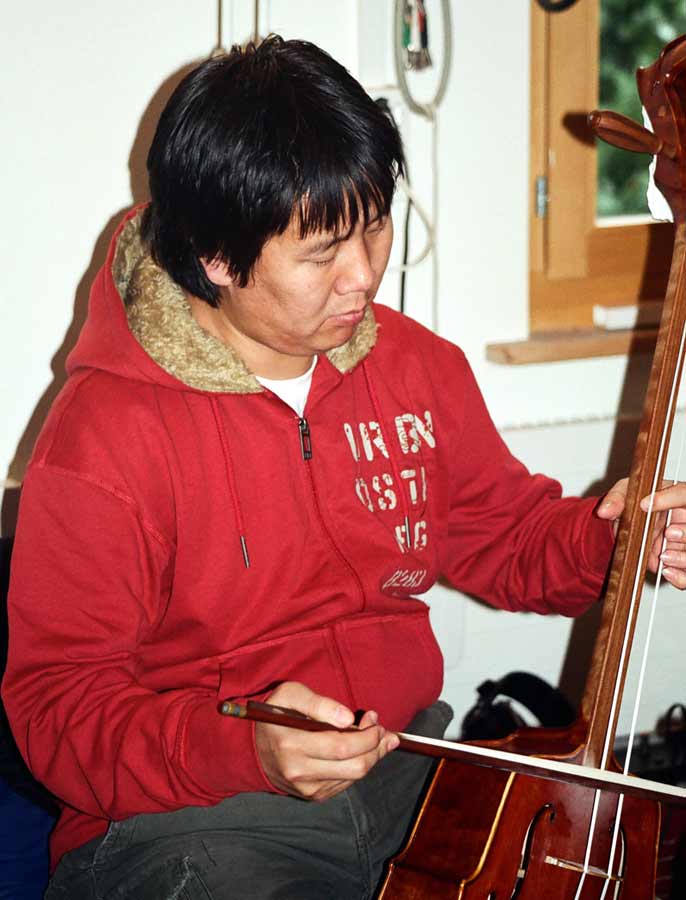
Nomin-Erdene Battulga: female voice, Togtokhjargal Buyankhishig: morin khuur |
|
|
|
6. Khuurkhun khaliun, yellow-brown horse – long song (besreg urtiin duu) |
|
- Nomin-Erdene Battulga: female voice, Togtokhjargal Buyankhishig: morin khuur |
|
Praisal song about a very good and beautiful horse and love in general. |
|
The song describes a yellow-brown good horse, on which one rides away from home and which should be taken care of, as danger is lurking, situations the horse is not ready to deal with yet. |
|
In this way we want to teach young people that they have to be careful when they leave home, that they have to be careful and attentive, as danger is lurking. We have to teach them how to properly deal with the new and the dangerous. |
|
|
|
7. Gariin arvan khuruu, ten fingers – short song (bogino duu) |
|
- Nomin-Erdene Battulga: female voice, Togtokhjargal Buyankhishig: morin khuur, Uyanga Gankhuya: khuuchir, Solongo Gankhuyag: yatga |
|
This song is about love. It also praises the beauty of nature, the love for animals and for one's home country. A prince falls in love with a girl from a poor family and wants to marry her. But the girl loves another young man who lives far away in another province of the country.
There are ten fingers on a hand, and there is a beautiful golden ring on my finger. But you are so far away from me. I do love, however, only you. I will love you, even if you are so far away from me. I love you more than I love my mother and my father. It is going to be hard to receive love, when you are so far away from me.
|
|
|
|
8. Khoyor setgel, two mind – short song (bogino duu) |
|
- Nomin-Erdene Battulga: female voice, Togtokhjargal Buyankhishig: morin khuur, Uyanga Gankhuya: khuuchir, Solongo Gankhuyag: yatga |
|
Foggy days are dark days. When the fog is gone, there will be clear days again.
I love you, my darling, among thousands of men. Cloudy days are darker days than clear days. When the wind and the clouds are gone, there will be sunnier days again. Many people are of the same opinion, but I, however, only have trust in you. |
|
|
|
9. Nariin khukh mori, a blue horse – long song (besreg urtiin duu) |
|
Traditional song from Eastern Mongolia (Zuun aimag). |
|
- Nomin-Erdene Battulga: female voice, Togtokhjargal Buyankhishig: morin khuur |
|
The song is about a fast blue horse (a racehorse). |
|
In autumn the horse breeders train their horses for the race on the following national day (Nadaam). They treat their horses very well and prepare them rather carefully for the race. They are treated well, as it is tradition in Mongolia to treat parents and neighbours well and give them little presents on the occasion of the "Greetings" (New Year's Festivities). |
|
There is worship of all four seasons, all animals as well as parents, ancestors and visitors. One treats others with highest respect. And children are taught to respect the environment, nature and other people, especially old people. In this way they are prepared for life. |
|
|
|
10. Khar mori, black horse – short song (bogino duu) |
|
- Nomin-Erdene Battulga: female voice, Togtokhjargal Buyankhishig: morin khuur, Uyanga Gankhuya: khuuchir, Solongo Gankhuyag: yatga |
|
Tonight a rider wants to visit his love Arshidmaa. He misses her very much, and now he wants to ride to her. But tonight the horse does not find the right way.
The song is about the rider's love, the girl he loves and misses so much and his love for his horse. |
|
When a lotus flower starts to bloom, people gather and enjoy the blooming. This is also the case when a young girl starts to bloom because it has fallen in love. |
|
|
|
11. Jiijuu khot – short song (bogino duu) |
|
- Nomin-Erdene Battulga: female voice, Togtokhjargal Buyankhishig: morin khuur, Uyanga Gankhuya: khuuchir, Solongo Gankhuyag: yatga |
|
Name of a little town.
|
|
The song is about the love between Binluu, the lover of Kharkhuu and Denzya, Kharkhuu's wife. Denzya and Kharkhuu are already married, but Kharkhuu and Binluu have just fallen in love with each other.
|
|
- First part: Denzya tells about her husband in Jiijuu khot and dreams of him.
|
|
- Second part: Binluu tells about her love for Denzya's husband. She knows that he is already married. When I am back in the mountains, I will have my horse and I will come to you.
|
|
- Third part: Kharkhuu confesses, I love you, Binluu, and I miss you very much. I am, however, already married, and if my wife learns that you want to visit me, she will be extremely angry. |
|
|
|
12. Arvaar avsan alag, ten coloured bought – short song (bogino duu) |
|
- Nomin-Erdene Battulga: female voice, Togtokhjargal Buyankhishig: morin khuur, Uyanga Gankhuya: khuuchir, Solongo Gankhuyag: yatga |
|
There is told the story of a greedy man who never had enough and was envious of everything other people owned, no matter if they had paid little or much. |
|
- Bought for ten horses, this will be a fat horse for sure.
- A ten-year-old girl will certainly be a future girlfriend.
- Bought for twenty yellow horses, this will certainly be the best.
- A twenty-year-old girl will certainly be a future wife.
- A horse will not get used to the saddle.
- A fourty-year-old woman will certainly always be faithful and loyal; she will never leave a young husband. |
|
|
|
13. Khoyor bor mori, two brown horses – long song (suman urtiin duu) |
|
Traditional song from Western Mongolia. |
|
- Nomin-Erdene Battulga: female voice, Togtokhjargal Buyankhishig: morin khuur |
|
A man owns two brown horses, which he needs for his daily work with his cattles. Two good souls, which he needs and also loves very much. |
|
The Mongols need horses for their daily work. The song is also about life in general and about patience and leniency towards man and animal. It is good to treat them well. |
|
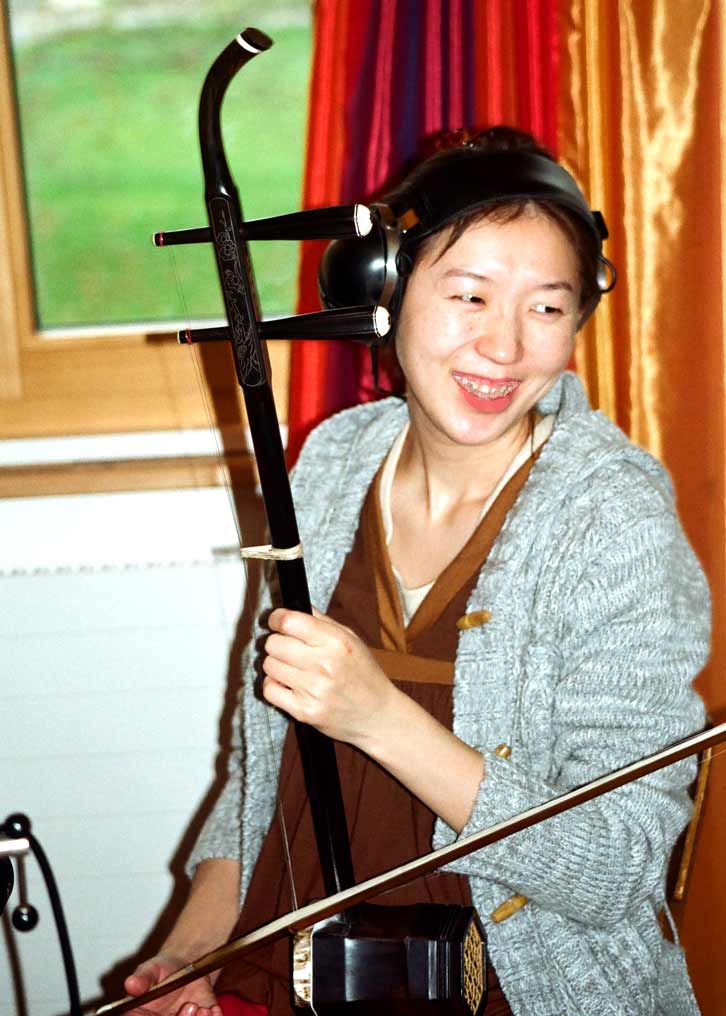 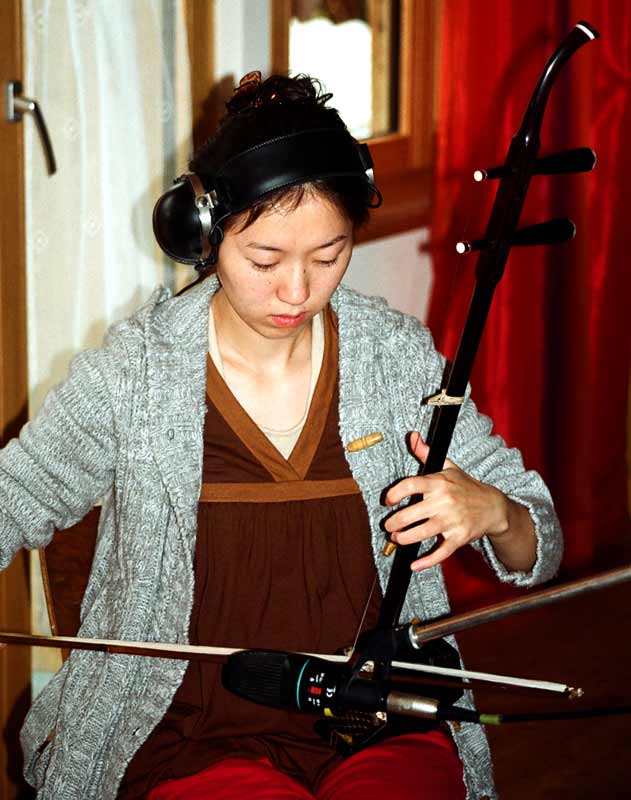
Uyanga Gankhuya: khuuchir |
|
|
|
14. Naiman arslant, eight lions – magtaal (praising song) |
|
Magtaal are sung in honour of the gods of Lamaism and the spirits of nature, heralds or in particular animals. Epic texts also contain praise songs for the mountains, the rivers, and nature in general. This is an ancient tradition still practised up to the present days by the tribes in the region of Mongol-Altai in Western Mongolia. |
|
- Nomin-Erdene Battulga: female voice, Togtokhjargal Buyankhishig: morin khuur |
|
The temple with the eight lions made from mahagony brings enlightenment and well being to the people. A praisal song about this temple. |
|
|
|
15. Shashnii duu – a Buddhist prayer |
|
- Nomin-Erdene Battulga: female voice, Solongo Gankhuyag: denshig, damar |
|
One confesses and pleads to be saved, however. |
|
Shajin magaa gunduubaar / Zogvii sanjaa bulaajii / Tugjii chanchiv Janraiseg
Janraiseglee chontsoiloo / Um mani bod mi khum. |
|
|
|
16. Asar undur – long song (aizam urtiin duu) |
|
Song of the Bayanbarat – Asar , the spiritual teacher in the tsam ritual dance. |
|
- Nomin-Erdene Battulga: female voice, Togtokhjargal Buyankhishig: morin khuur |
|
Contemplation, heart, soul and spirit. |
|
People ought to live happily and enjoy their daily life. They are supposed to love their fellow people, the animals and the environment, and they are supposed to treat them well. |
|
The song describes the daily life of the nomads with all the ups and downs of life. Good people with a clear conscience will have a better life. |
|
|
|
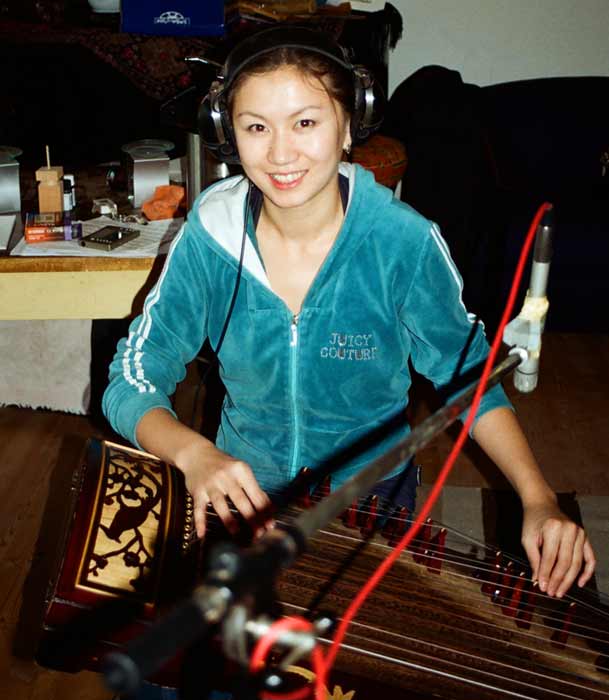 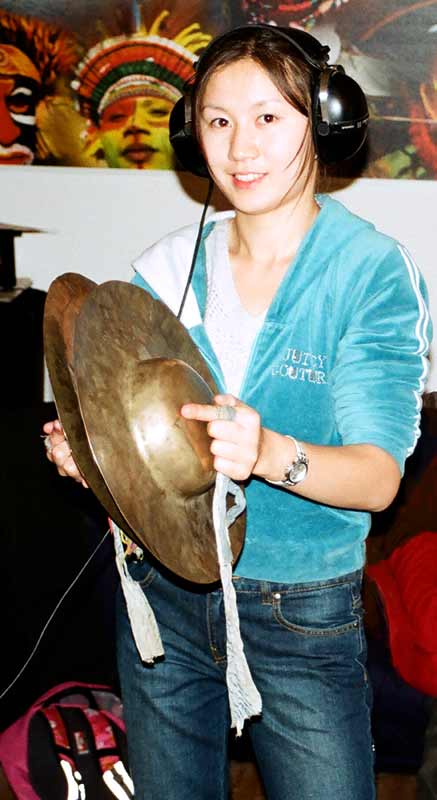 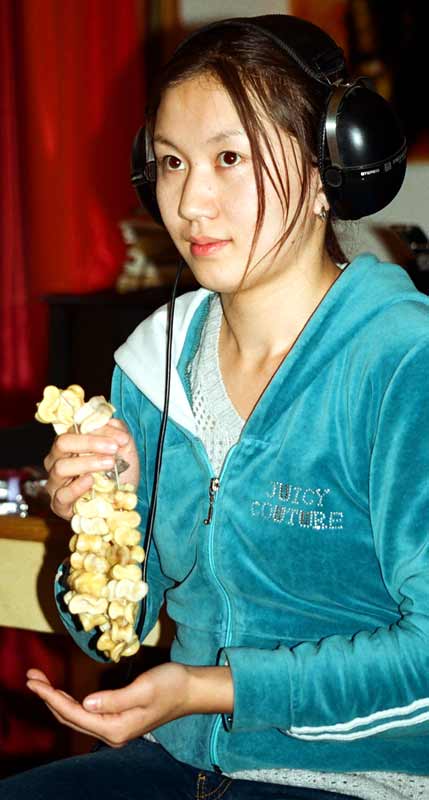
Solongo Gankhuyag: yatga, cymbals, rattle |
Instruments
- Khuuchir (string instrument)
Formerly, the nomads (called "the savages") mainly used the snake skin violin or horsetail violin. The Chinese call it "the Mongol instrument" or "Huk'in". It is tuned in the interval of a fifth and is small or middle sized.
- Morin khuur (string instrument - horse-head-violin)
The morin khuur is a typical Mongolian two-stringed instrument. The body and the neck are carved from wood. The end of the neck has the form of a horsehead and the sound is similar to that of a violin or a cello. The strings are made of dried deer or mountain sheep sinews. It is played with a bow made of willow, stringed with horsetail hair and coated with larch or cedar wood resin.
- Yatga (string instrument)
 |
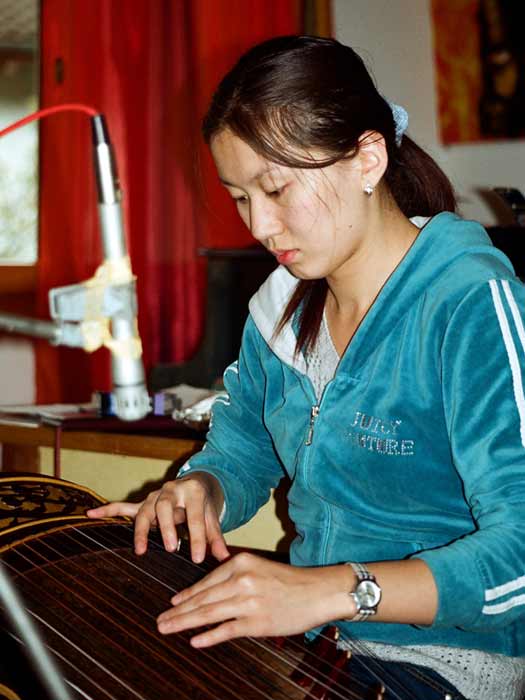
Solongo Gankhuyag: yatga |
The yatga is a half-tube zither with a movable bridge. It is constructed as a box with a convex surface and an end bent towards the ground. The strings are plucked and the sound is very smooth. The instrument was considered to be sacrosanct and playing it was a rite, bound to taboos. The instrument was mainly used at court and in monasteries, since strings symbolised the twelve levels of the palace hierarchy.
Shepherds were forbidden to play the twelve-stringed zither, but they were allowed to play the ten-stringed zither, which was also used for interludes during recitations of epics.
- Denshig – small bells (percussion instrument)
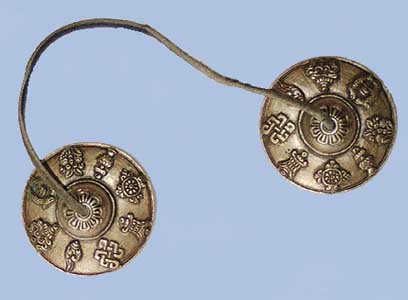
They are only used in the Mongolian and Tibetian region. These are two plainished brass plates, the grips (knobs) of which are connected by means of a small band. On the occasion of services, a lama bangs the two little plates together, thereby producing a sound similar to the touch of a small bell but significantly softer and more melodic.
- Damar (percussion instrument)
Small drums used in monasteries, a wooden casing with resemblance to a coil. On both outer surfaces it is coated with leather. In the middle of the coil there is a band made from silk with emobroidery and two buttons attached to a string. By moving back and forth, these two buttons are hit on the stretched leather of this small drum.
Revised by Hermelinde Steiner
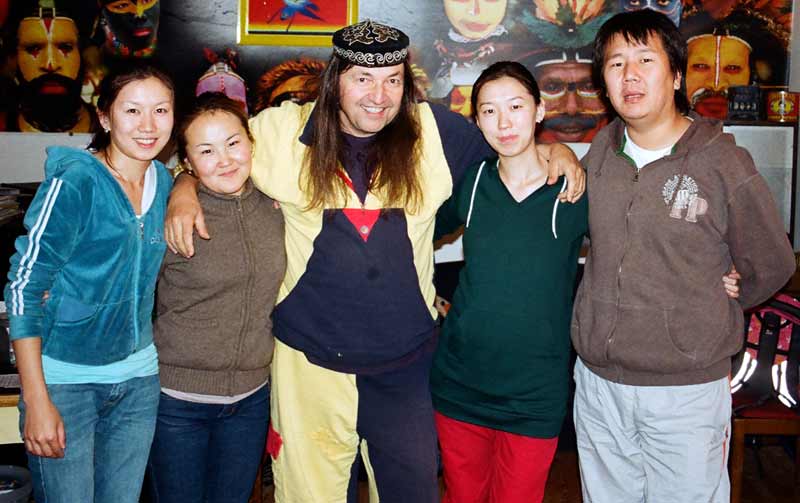
Solongo, Nomin, Fizzè, Uyanga and Buyan
|
